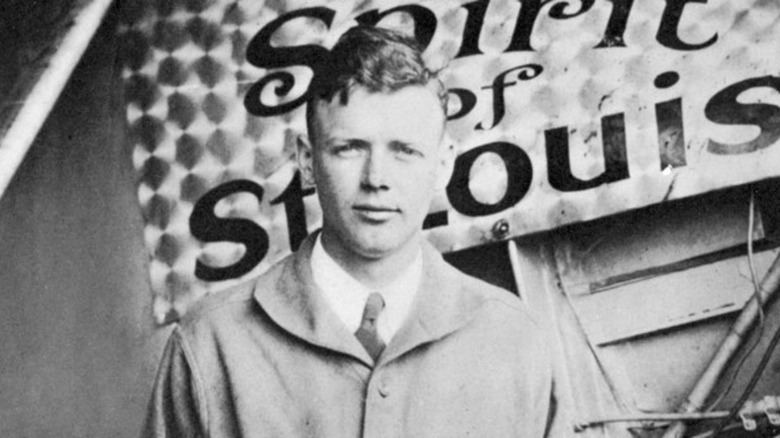Charles Lindbergh Took A Surprisingly Small Amount Of Food On His Transatlantic Trip
Famed aviator Charles Lindbergh set off on a daring and dangerous mission on May 20, 1927, flying out of New York's Roosevelt Field (via History). His intention was to make history with his plane, "The Spirit of St. Louis," by becoming the first person to fly solo nonstop across the Atlantic. His journey took him from New York to Paris, and what food he packed for this adventure surprised many.
Lindbergh, born in 1902, was no stranger to risky challenges. With some help from his father, he bought his first plane in 1923 without even having any training as a pilot, per the Charles Lindbergh House and Museum. Lindbergh enrolled in the U.S. Army flying program the following year. During his training, he had his first taste of the hazards of flying in 1925 when he had to bail out of his plane during a midair crash. Lindbergh became a second lieutenant in the Air Service Reserve Corps upon his graduation.
Before long, he made a potentially dicey career move, signing on to work as an air mail pilot. Lindbergh battled all sorts of weather as an air mail pilot, but he soon decided to take on an even more life-threatening goal, one that he hoped would win him a $25,000 prize.
Charles Lindbergh traveled light
Lindbergh wanted to win the Orteig Prize and the impressive amount of cash came with the honor. This prize was created by French hotel owner Raymond Orteig for the pilot who could fly nonstop between New York and Paris (via History). Lindbergh got financial backers who helped underwrite the construction of a special airplane that he could use for what he hoped would be his award-winning flight, according to the Charles Lindbergh House and Museum. The new aircraft was built by a San Diego firm, Ryan Aeronautical Co. Lindbergh took the plane out for more than 20 test flights before he thought that it was ready for the transatlantic journey.
On the morning of May 20, 1927, Lindbergh prepared to take off. He hadn't slept well the night before; reportedly a reporter's loud card game had made it impossible for the aviator to rest. But that didn't stop him. Lindbergh took off in his specially designed plane, which had extra fuel tanks and lengthened wings, for the long trip across the Atlantic. To accommodate this heavy load, he had cut weight in other areas –- no parachute and no radio, among other omitted items. This idea of traveling light also seemed to come into play where food was concerned. Lindbergh only packed the bare essentials.
Charles Lindbergh only brought a few food items
Lindbergh was clearly more focused on flying than eating on his transatlantic effort. He brought five sandwiches with him, according to Lapham's Quarterly. He reportedly explained his limited culinary menu when he said, "If I get to Paris, I won't need any more, and if I don't get to Paris, I won't need any more either." He also brought five cans of army rations and a few liters of water, per Nestlé.
Going hungry was apparently part of Lindbergh's strategy for staying awake during the long flight (via USA Today). He even held off eating his provisions for a time to remain alert. But Lindbergh might have done better if he had packed himself a thermos of coffee. The lack of sleep caught up with him during the trip and he started having hallucinations. Lindbergh thought there were other spirits with him in the journey, and these entities proved to be helpful, coaching him on his way. (Lindbergh revealed his ghostly encounters decades after his historic flight in his 1953 book "The Spirit of St. Louis.")
After 33 1/2 hours in the air, Lindbergh finally arrived in Paris on May 21 at 10:22 p.m., per History. He was heralded as a hero by approximately 150,000 people who turned out in person to welcome the American aviator to Paris, per the Charles Lindbergh House and Museum. But there's no word on what he had for his first meal in France.


